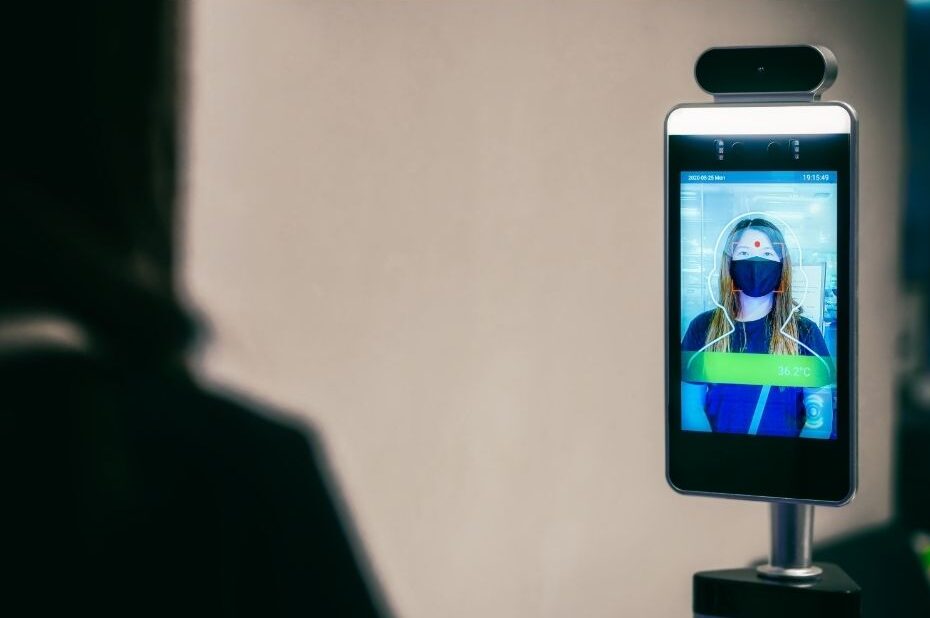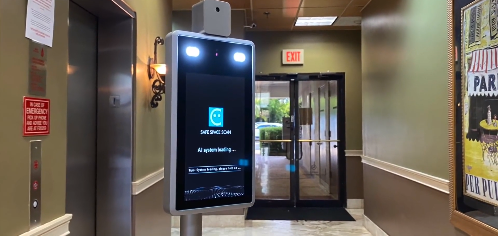If you’re looking for ways to improve the safety, efficiency and ease of your customer or employee screening process, touchless thermal temperature scanners offer all of those benefits in one convenient package. These tools offer a straightforward but powerful advantage to businesses that want to do their part in preventing the spread of illnesses and keeping their employees and clients as safe as possible.
An automated temperature screening tool can eliminate human involvement in taking someone’s temperature while offering impressive accuracy and speed. Plus, they can integrate with your access control system so you ensure that only healthy individuals enter your facility. Let’s take a closer look at touchless thermal screening machines and what they can do for your business.
How Does a Touchless Thermometer System Work?
Touchless temperature screening systems use advanced thermal imaging to detect infrared rays emitted from a person’s body. These rays indicate heat, and the scanner can convert that reading into a temperature measurement. While we typically consider 98.6℉ to be healthy body temperature, the normal range can span from 97℉ to 99℉.
If the scanner senses someone with a temperature above that range, it will release an alert, after which company policy kicks in. Usually, a high temperature indicates a fever, which can be a symptom of infectious disease and is grounds for being sent home. Instead of just an alert, the scanner can also combine with access control systems, so someone physically cannot enter the building without a passing temperature.
While features can vary from system to system, one prominent system offers evaluation times of less than a second and accuracy within 0.3℉. It’s easy to use and offers several safety features.
Here are some of the other features that thermal screening tools can offer:
- Positioning: Artificial intelligence (AI) can step in to ensure that someone stands in the correct spot for an accurate reading. If someone is too far away or too close, it may give audible instructions or visual cues for the person to step forward or back so they are in the optimal spot for a reliable measurement.
- Fast response times: Systems can provide a pass/fail result in under a second — 300 milliseconds (ms), to be specific. This is a fast response in the world of no-touch thermometers. Employees and customers can spend less time being screened and more time working, shopping or doing whatever it is they came to your facility to do.
- Accurate results: If you’re wondering how accurate infrared thermometers are on humans, the answer is “very.” Reputable instruments can provide temperatures within 0.3℉. With more accurate measurements, you can avoid false results and trust that the people who pass are within a safe range.
- Mask checks: In addition to scanning for temperatures, you can also check if someone is wearing a mask and remind them to put one on if needed.
- Clear alerts: Whether someone passes or fails the scan, an audible sound will play, along with a visual display. You can be on alert for employees or customers who fail the scan and send them away if needed.
- Completely contact-free operation: With a contactless system, no one has to operate the scanner and everyone can stay far apart from each other. It is easy to use, so you shouldn’t need to provide much background information, if any, for people to understand it. Without an explanation, you can reduce the need for contact with another person.
- Record-keeping: With an evolving landscape of health guidelines and requirements, it always helps to keep information on file. You can maintain data complete with images, temperature readings and other data points.
What Are the Benefits of an Automated Temperature Screening Machine?
As we’ve mentioned, you’ll see several types of benefits from fever screening thermal solutions, including improvements to efficiency, safety, costs and security, as well as employee and customer satisfaction. With these tools, you can:
- Enhance safety: Of course, by barring high-temperature individuals from entering the building, you prevent whatever germs they’re carrying from entering, too. It keeps healthy individuals from exposure to infection and helps to identify when someone shows a symptom they might not have been aware of. In addition, you can require masks before allowing entry, so you’ll encourage safe practices during the screening process.
- Minimize invasive or obtrusive practices: Traditional screening, with an infrared temperature “gun” pointed at someone’s forehead, can be obtrusive or upsetting. When used on employees, it can feel like they’re being challenged every time they walk into their shift, and customers have even less of an incentive to deal with it. With a display-based scan, it feels more like getting their picture taken. It is a much friendlier, appealing process for everyone.
- Reduce human contact: Other screening practices may involve having another employee or supervisor take someone’s temperature. That adds another person into the mix and can further the spread of germs for both the operator and the person being scanned. A fully automated system eliminates this extra contact.
- Save on labor: If you’ve got a supervisor scanning every employee or a receptionist scanning all of your clients, it likely takes a lot of time out of their day. They might spend half of their shift just operating a thermal temperature scanner. An automated system gives that time back, so employees can spend time working, not scanning.
Can the System be Used for Access Control?
Thermal temperature scanners can link up to access control systems for extra security, safety and automation.
Access control systems can automatically let people into the building or provide access to resources only after successful verification of body temperature and facial recognition. It can help you further secure your facility, so only healthy people can enter. You can also use it to restrict access if your employees and customers aren’t wearing masks.
Temperature screenings are the perfect tool to link up facial recognition. Systems offer plenty of room for most businesses to incorporate their facial identification system. With a library of up to 22,400 faces and over 100,000 records, you can match each employee against your database before they can enter. Only authorized personnel with an acceptable body temperature will pass the screening.
Incorporating access controls with automated temperature screening allows you to:
- Be more efficient: An all-in-one approach is quick, and you can even use this feature as a time clock, rolling multiple steps into one to save time and boost efficiency. Face recognition can occur within 500 ms and make this a speedy process.
- Reduce face-to-face contact: Using automated temperature screening can help to modify traditional security procedures in the wake of illness outbreaks and reduce personal contact. Maybe you normally have a security guard grant access upon visual confirmation of someone’s identity, or perhaps a manager has to let someone in the building. An automated temperature screening machine that controls access can remove this person-to-person contact and free up other workers’ time.
Where Can the System be Installed?
No-touch thermal temperature scanners are excellent in a wide variety of settings. Any place that has a lot of individuals going in and out or gatherings of multiple people and wants to prevent the spread of viruses can benefit from this technology. The necessity of scanning applies to both employees and customers, so you can focus on keeping everyone safe and set up your scanner where it will be most convenient.
Some of the places that use touchless temperature screen systems include:
- Medical and dental offices
- Long-term living or care facilities
- Manufacturing plants
- Retail stores
- Banks
- Hotels
- Offices
- Restaurants
- Salons
- Government services like the post office and the Department of Motor Vehicles
Of course, this list is just a small example of where no-touch thermometers work well. In the changing health needs of today’s world, automated temperature screening would be a smart move in nearly any location where more than a few people could gather.
As far as physical placement goes, thermal temperature scanners are quite versatile. They come as a stand-alone unit that you can place wherever necessary, whether that’s on a counter or a stand. Both types of stands come in professional, decorative options. Some businesses choose to place them at the entrance or near a counter where an employee can inform customers what to do if needed, but it is still an unattended system, so you don’t have to worry about keeping it staffed at all hours.
The Federal Drug Administration (FDA) does have a few suggestions for placing non-contact infrared thermometers. They say you should place the scanner:
- In a draft-free space.
- Outside of direct sunlight.
- Away from radiant heat sources.
- In an environment between 60.8℉ and 104℉ and with relative humidity below 85%.
- In its location 10-30 minutes before using it.
With a display that is dust and water-resistant, you have a lot of freedom in where you can place the system, so you can find somewhere that works in your company’s unique layout. The 7-inch HD screen provides real-time feedback, too, so you can readily see what the camera sees and adjust the position as needed. Just remember that while it is water- and dust-resistant, it is not weatherproof, and direct sunlight can add heat, so the best placement is indoors.
How the System Can Protect Customers and Employees
For the most part, people don’t knowingly put others at risk. Unfortunately, many viruses and bacteria don’t present themselves with symptoms until several days or weeks after the initial infection. Asymptomatic people can bring illness around with them everywhere they go, exposing each person they run into.
Depending on the methods of transmission, we may need to take different approaches to stay healthy and keep those around us healthy. Transmission can occur in several different ways, such as:
- Direct contact: Touching other infected individuals.
- Indirect contact: Touching an object previously touched by an infected individual.
- Droplet contact: Coming into contact with droplets emitted from an infected individual from activities like coughing and sneezing. These droplets only stay in the air for short distances, so a distance of about 6 feet is typically recommended.
There are other transmission methods, of course, but these three are some of the most prevalent, and a no-touch temperature screener bypasses them by eliminating touching the device and keeping the person away from contact with another human.
A fever is a common first symptom of illness, and people may not even be aware of it if they have one. Screening for body temperature and appropriate mask practices is an excellent way to reduce the risk of infected persons entering your facility and spreading viruses to others. There are several types of screening, but currently, body temperature is one of the most relevant and widely used approaches.
Touchless temperature screening systems are one of the best methods to reduce contact between people in your facility. In fact, the Centers for Disease Control (CDC) recommends implementing screening practices in many locations as a way to limit the spread of germs.
Why Use Touchless Thermal Screening?
According to the FDA, non-contact infrared thermometers (NCITs) may help reduce cross-contamination and the risk of spreading diseases, as opposed to traditional infrared thermometers. They are easy to clean and use, making them accessible and safe for many people, not just trained medical professionals. NCIT, however, often refers to a thermometer that uses infrared but must be operated by a person, which is less safe and pulls staff away from their work.
The biggest issue with traditional NCITs is that the operator must bring the thermometer relatively close to the person being scanned, usually within a few inches. They may be too close to maintain appropriate safety and social distancing measures. Even with proper personal protective equipment, this puts both parties at unnecessary risk. With an automated, touchless temperature screening machine, there is no other human involved. There isn’t even an item to touch. It is fully contactless, allowing workers and customers to abide by social distancing and stay safer.

Another bonus with an automated system is that it can detect temperatures over a larger part of the body, typically the head and face. The NCIT, on the other hand, just measures a specific point on the forehead. The touchless system also enables other features such as mask detection and face recognition.
With a convenient piece of technology like this available, you can show your clients and customers that you take their safety seriously and that you are committed to doing your part in slowing the spread of diseases.
Keep Employees and Customers Safe
Whether you run a large warehouse with strict security measures or a small office with just a few employees, an automated temperature screening system is an excellent way to keep illnesses out of your workplace. It can help you avoid unsafe screening practices by completely eliminating a second person. Plus, it can make your employees and customers feel safer and more confident that they are in a healthy work environment.

